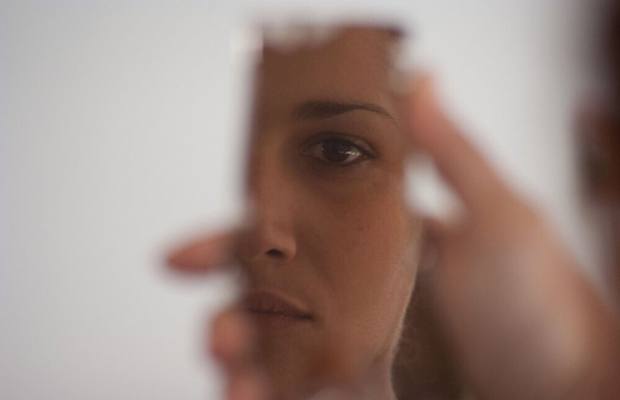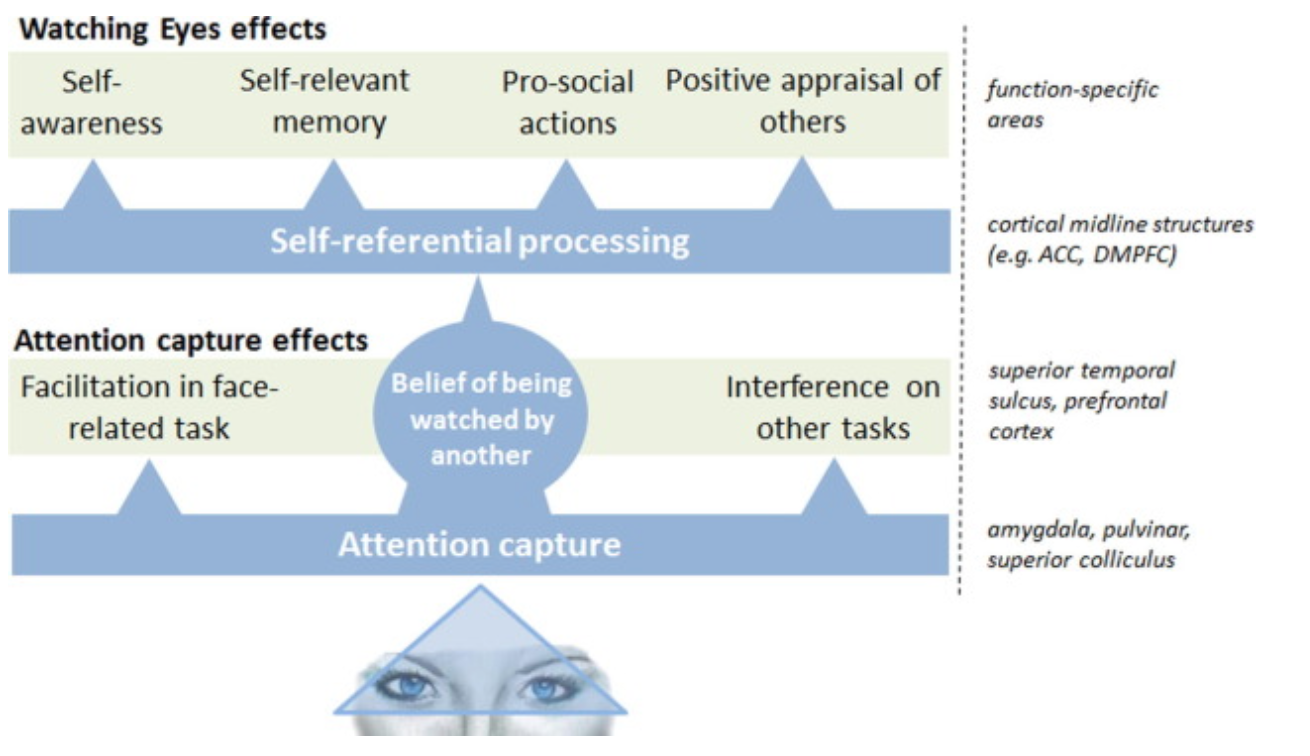Hormeze • • 15 min read
Awareness, Squared: The Power of Eye Contact and Mirror Meditation

“So much can be said in a glance. Such ambiguous intensity, both invasive and vulnerable—glittering black, bottomless and opaque. The eye is a keyhole, through which the world pours in and a world spills out. And for a few seconds, you can peek through into a vault, that contains everything they are. But whether the eyes are the windows of the soul or the doors of perception, it doesn’t matter: you’re still standing on the outside of the house. Eye contact isn’t really contact at all. It’s only ever a glance, a near miss, that you can only feel as it slips past you… So we’re all just exchanging glances, trying to tell each other who we are, trying to catch a glimpse of ourselves, feeling around in the darkness.”
— The Dictionary of Obscure Sorrows
Meditation changed my life. For many years, I had been desperately trying to understand myself, the secret to happiness, and the cure to my suffering. But in all that time, I had never really taken the time to simply sit and study the experience of being in a disciplined, patient manner. When I was introduced to the idea that directly observing the mind could yield insights into its nature, its sheer simplicity felt like a smack in the face. Of course!
Within just a few months of daily practice, things began progressing quickly. The tyrant in my mind was no longer the only show in town. An unflappable, non-judgmental, loving awareness started to compete with the neurotic and brutal voices in my head. My experiences, when observed from this new perspective, were changing in increasingly surprising and profound ways. As this continued, the value I saw in simply witnessing, in simply being witnessed grew exponentially. Taking the time to experience the real thing, as opposed to our ideas about a thing, is always deeply rewarding. This is especially true of the experience of being aware.
But meditation isn’t all roses and chubby Buddha’s belly laughing the suffering away. It can be challenging, painful, and even terrifying to sit with our own thoughts, our emotions, and the constant electric flow of stimuli from our nervous systems.
Fortunately, we can do this for each other. We can be the loving awareness we may struggle to be for ourselves, for the people we love or are trying to love. It’s possible to move beyond fleeting glances, and slow down, even for just a few intentional moments and give each other the full undivided attention we so deeply crave. Meditation isn’t something done only in the isolation of our own internal worlds, it is also something we can share with the people we wish to connect with the most. It is these practices — eye contact and mirror meditation — that I will be discussing in detail.
Meditation on the Mediterranean
“Feel the consciousness of each person as your own consciousness. So, leaving aside concern for yourself, become each being.”
— Vijñāna Bhairava Tantra
My obsession with eye contact meditation started the first time I tried it. I was camping on the shore of the Mediterranean sea with the owner of a lovely pair of eyes and even more lovely awareness abiding behind them. I suggested the idea a bit after the sun had set, as we sat singing by the campfire. We set a ten-minute timer in the form of a wonderful song and began what was to become our first eye contact meditation.
We sat by the fire, holding our gazes, witnessing. Our faces wore grins we eventually swallowed as the inevitable intensity of the experience seeped in. As we settled further, a curious thing happened. I began to hallucinate, which I learned later is actually common with this technique. My partner’s face grew in size, changed hues, and snapped in and out of focus in novel ways. Meanwhile, she was experiencing what she described as a unique warmth filling her body.
Neither of these things was as wonderful and intense as the main event — pouring our awareness on each other; loving, being loved; accepting, being accepted. It was a long ten minutes, in the best way minutes can be long. Halfway through, the tears came — my favorite kind of tears, to which no specific emotion can be attributed. They rolled down and out just as the fear did, and a profound sense of relief came over me. It was so powerful that I began to shake. This lasted for an additional ten intense, healing minutes. When it was over, we stared at each other with a new flavor: disbelief. The power of this wonderful tool had made itself known in our campsite. I’ll never forget that night.
Further Exploration
I tried the technique shortly after this experience with another pair of lovely eyes, and the same even more lovely awareness behind them. Again, initial discomfort and eye shifting gave way quickly to light, painless tears. We smiled as we watched them crest over each other’s eyes and down our cheeks. When it was over, more disbelief and more loving awareness. I was hooked.
The heady sensation of increased presence and awareness was like a shot of spiritual adrenaline in my heart. This is the stuff! I remember thinking. This practice gets right to the heart of what humans desire in their contact with the other and with the self — to witness without judgment, with loving awareness, zero expectation, and no clinging or aversion. In a society plagued by an epidemic of loneliness, being lovingly witnessed and accepted is an efficacious antidote.
Perhaps unsurprisingly, both friends I tried this with initially were female, and I had a harder time convincing my male friends to stare lovingly into my eyes while a timer counted the seconds. This is indicative of a culture that practically prohibits platonic male affection, which is a dragon that I think can be slain, at least partially by this wonderful tool. When I did finally sit down across from some of my closest male friends and held their gaze, they agreed it was definitely worth it. Sometimes there were tears, other times, laughter. At times we hallucinated, and on other, we sighed and yawned for a bit and enjoyed each other’s presence. And every time, our minds settled, our presence increased, and our love shone.
My fascination increased as well. I tried eye contact everywhere I went, with everyone and everything I could: a van Gogh portrait in Amsterdam, a toddler on the bus to Safed, and a Buddha statue in Myanmar. All three brought me to tears; the immediacy and intensity I felt wet my palate for more. I began to introduce more chemicals into the equation. My first experience had been assisted by cannabis, but my most intense eye contact experiences took place under the influence of all manner of useful compounds; psychedelics for the most part, as well as some entactogens and dissociatives.

The Ecstasy of Direct Gaze
It seemed like as good a time as any; three hours into our first ever dose of MDMA, our brains soaking in all our favorite neurotransmitters. We set up chairs and a good song. The calm confidence of our practice and drug-induced, low-grade euphoria swept the usual discomfort away. It felt like a small eternity. In a way, it was like we were bringing our practices together; as though we had invited each other into the sanctuary of our respective meditations.
Eventually, my friend’s face began to crinkle. I could feel sadness’s slow burn in my chest as it spread through his face and began to crawl out of his eyes, eventually bending him over. He sobbed there for a while, squeezing himself clean. Sometime later, he sat back up and we resumed. When the timer went off it sounded ludicrous – why would we ever plan to tear our gaze away from each other? We turned it off and continued.
Later I wrote this, to describe the moment:
In the mirror
I see only that which sees
And I like what I see
And so does he
So we set up chairs
Cross our legs
And behold in each other
That in which we abide
Within ourselves.
A few months later, in a cabin by the ocean, on more mushrooms than we had ever ingested, we lit a candle between us and pressed play on an appropriate song. Almost immediately, my friend’s face morphed and grew and changed. Eventually the side of his face lit by the candle appeared to emit light like a star, and the other side appeared to have been replaced by a black hole. It was stunning. This time it was my turn to cry. The tears rolled effortlessly and silently. At times it felt incredibly intense, almost as though the loving awareness was making a sound loud enough to shatter the windows of that tiny cabin.
Every experience with this technique left me feeling as though we all have a deficit of being held in loving awareness. Subsequent eye contact felt increasingly delicious and natural. I felt more comfortable in my skin and more positive towards my friends. The more I do it, the more it pains me that we have an available tool capable of increasing our love and acceptance toward each other that isn’t being properly utilized.
Mirror Meditation
“We are the mirror, as well as the face in it. We are tasting the taste of eternity this minute.
We are pain and what cures pain. We are the sweet cold water and the jar that pours. Soul of the world, no life, nor world remain, no beautiful women and men longing. Only this ancient love circling the holy black stone of nothing. Where the lover is the loved, the horizon and everything within it.”
— Rumi
In my opinion, a lot of what makes eye gazing meditation worthwhile is accessible through mirror meditation. Many of the recorded effects of eye contact were also observed in people who eye gazed with images of faces with open eyes. In addition to this, mirrors have their own advantages. Psychologists have conducted studies using mirrors and video technology to help people recognize their own emotions and to teach them “self-mirroring,” which enables self-soothing behaviors in anxious subjects. Mirrors have also been used to treat body dysmorphic disorders. One of the most famous uses for mirrors in medicine is that of V. S. Ramachandran. His medical mirror device enables a shift in self-perception that heals people with phantom limb syndrome (pain that feels like it’s coming from a body part that’s no longer there). I propose that mirror gazing can help us with a different phantom syndrome — the illusion of self.
On one occasion, while on LSD, I found myself in a bathroom with a single bare bulb hanging above my head, facing a dirty mirror. As I stared at my reflection, the bulb began to circle my head, flinging shadows across my face as it moved. Inside the chaos of shapes that replaced my head, a new face emerged. It was gleaming, golden, full of light. The bulb kept spinning as I saw the most beautiful version of myself – some sort of Hindu god, complete with six arms, an aura, beaming eyes, the whole ninety billion yards. I felt true love towards this self in a very novel way. The bulb kept spinning, revealing yet another self. This one with red skin, sinister, and mischievous eyes. It was clearly evident that this being was just as much me as the divine thing it had replaced. What was surprising though, was that the degree of love and self-acceptance hadn’t changed at all. This was a revelation for me. A new, more complete and unconditional self-love and acceptance stayed with me after the LSD had faded. It was one of my most powerful experiences with that blissful molecule; I remember it fondly to this day.
This isn’t to say Mirror Meditation can’t be rough (especially on psychedelics). Philosopher Thomas Metzinger describes a brutal aspect of this experience succinctly:
“The illusion is irresistible. Behind every face there is a self. We see the signal of consciousness in a gleaming eye and imagine some ethereal space beneath the vault of the skull, lit by shifting patterns of feeling and thought, charged with intention. An essence. But what do we find in that space behind the face, when we look? The brute fact is there is nothing but material substance: flesh and blood and bone and brain…You look down into an open head, watching the brain pulsate, watching the surgeon tug and probe, and you understand with absolute conviction that there is nothing more to it. There’s no one there.”
Being faced with an accurate vision of ourselves instead of experiencing ideas of ourselves can demonstrate just how far removed from reality our minds can be. This can be uncomfortable for many reasons; for example, we all carry a degree of shame about our bodies in one way or another, and facing that can be intense. It is here that meditative insight can be especially helpful; by grounding ourselves in awareness instead of our egos, we see ourselves as we see any other object of awareness, such as clouds. And as Philosopher Alan Watts says, there are no misshapen clouds.

The Science of Eye Contact
A large amount of the information found in this section was taken from the wonderful meta-analysis of many studies on the subject, entitled ‘Watching Eyes effects: When others meet the self’. (1)
Observing the Lizard Mind
For a long part of our histories, stretching beyond even our mammalian ancestors, sustained eye contact was a threat behavior. It often meant some form of violent natural selection was about to go down. Part of eye contacts profound intimacy is intensified by its tendency to trigger an ancient ‘cold-blooded’ part of our brain, giving rise to fear emotions – powerful stimuli designed to motivate animals like us into fight or flight. This is when the mindfulness kicks in; It enables stillness in the mental storm that screams at you to move. Just as you are lovingly- or at least non-judgmentally — witnessing the packet of stardust that is your meditation partner, one need only observe the voice of the lizard brain in order to change one’s relationship with it. By witnessing, instead of reacting, this possibility of fear can be rendered a non-issue.
Attention Capture
Eye gazing has profound effects on cognition. It is empirically proven that in human interactions, eyes are the first and most explored area of the face. This is an innate behavior — even newborn babies have a preference for direct eye contact. During eye contact, face-oriented attention increases to the extent that it interferes with any secondary task, as well as peripheral vision. Increase in heart rate and arousal has also been noted. This boost in attention can aid in the process of meditation, which could generally be described as a technique for altering states of focus.
Enhancement of Self-awareness
Genuine eye contact increases self-referential processing, which may favor prosocial actions, positive appraisals, memory, and self-awareness. People primed by a few minutes of direct gazing are better at evaluating their own bodily responses to emotionally evocative photos, proving that eye gazing not only increases sensitivity to how one is perceived but also to how one perceives oneself, in one’s own body.
Increased clarity and sensitivity to one’s own physiological state is an essential part of healing from trauma and increasing one’s well being and lived experience in the present moment. Enhancing self-awareness can lead to increased insight into the nature of the self, which is valuable for anyone interested in self-inquiry styles of meditation.
Activation of Pro-Social Behaviors
The wonderfully titled study ‘Looking and loving: The effects of mutual gaze on feelings of romantic love’ (2) describes how participants who spent just four minutes holding each other’s gaze, in conjunction with asking each other 36 prewritten questions, reported increased feelings of love for each other. Another study mentions that several of their subjects ended up getting engaged within a year of participation!
Direct Gaze has also been shown to favor mimicry such as copying facial expressions, body positioning, etc., which facilitates social interaction by reflecting affiliation intent. This can have pronounced pro-social effects. EEG (a test that detects abnormalities in the electrical activity of your brain) activity shows that during direct gazing, an asymmetric, left-sided frontal EEG activation is elicited, indicating ‘a motivational tendency to approach’ — as opposed to right-sided frontal activation, which indicates avoidance.
Direct gaze also increases positive appraisals of others. People tend to rate their gazing partners as more likable, credible, and imbued with self-esteem, compared to someone with whom minimal eye contact was shared. Another study shows gaze partners rated as more “potent, attractive, and mature.”
The researchers conclude:
“We propose that direct gaze has a self-referential power: It automatically triggers a cognitive background centered on the self that leads to the various positive effects of direct gaze on cognition… Indeed, a better understanding of these effects may open new avenues for remediation and amelioration of quality of life in various diseases… Direct gaze has a therapeutic potential that should be delineated.”

Final Thoughts
The Neuroscientist, philosopher, and meditation teacher Sam Harris brilliantly synthesizes these two techniques and their ramifications for the ego in his new meditation series, entitled ‘Waking Up’ (some light paraphrasing has been added for clarity):
“Look for yourself. Where is your face? Where is your head? Where is the seat of your attention in this moment? There is something to glimpse here that can become a new basis for mindfulness. It can also change your interactions with other people. It is possible to look for yourself in this way, and to fail to find it in a way that changes your perception of the world and of consciousness in each moment. The center can drop out of experience, leaving just the world. This can be quite liberating.
Notice when you look at your own face, this is identical in visual terms to every social encounter you ever had. You are simply looking at the face of another person. As you look at your partner, making eye contact with you, it’s quite possible to follow their gaze back to where you think you are and to fail to find yourself, in a way that opens consciousness to an experience of center-less totality.
In a social encounter this means many things. it means, above all, that there is no place from which to be neurotic. There is no place from which to be self-conscious. Thoughts and emotions can continue to arise but when you are looking at another person and they are looking at you and you no longer feel that you are behind your face, you no longer feel like your behind the mask of your face. Rather you are nowhere. You are simply the condition in which they are appearing. That is an experience of total freedom, psychologically in the presence of another. your attention is totally free to hear them to see them, and relate to them from a position that is completely free of egocentricity. It is literally free of ego, because the ego is simply that feeling of being behind your face.”
Meditation is full of paradoxes. We are motivated to lose or transcend our egos, but the ‘we’ that is motivated to do so is often the very ego we wish to transcend. The idea that we can improve our meditation through social practice may seem to carry contradictions as well, especially when so much of the pain we are processing in meditation is caused by others. But as psychiatrist Stephen Porges says, “Safety resides in connection, not in an absence of threat.” I believe that these twin techniques offer a unique and direct way to reach this connective safety. To find healing, we need to find each other. To find each other, we need to find ourselves.
A Practical Guide to Eye Contact Meditation
- Decide prior to beginning whether you’d like to employ an intentional technique like Metta (loving-kindness) style meditation, which can be a very helpful technique for enhancing eye gazing. In Metta meditation, one stokes the fire of loving kindness first towards the face of a loved one, then a friend, eventually the whole world and all its strangers, and finally one’s self. A similar thing can be done with eye contact – first cultivating some towards the face of your meditation partner, then back to one’s self, or vice versa. Alternatively, a simple ‘do-nothing’ approach is fine as well; simply gaze into the eyes of your partners and wait and see what happens.
- Decide on your preferred lighting. A well-lit room will be good for clearly seeing your partners face, but low light seems to increase the chances of hallucinations occurring.
- Set a spot to sit at a comfortable distance from your partner
- Set a timer for the desired amount of time. Or make a playlist with music that will last for the desired duration.
- Get in a comfortable seated position.
- Focus on your partner’s eyes. It can be tempting to focus on one eye, or a spot elsewhere on the face. It’s best to avoid this, as it can be distracting for your partner. Leave some time for experimenting where to best focus your gaze so that you can take both eyes in (with the whole face in the periphery). Try to stick with one spot.
- As a beginner, self-consciousness, worries about the technical details of the practice, and general discomfort with the vulnerability one encounters are likely to arise in one consciousness. Just as with general meditation gently acknowledge these thoughts and allow them to pass by like a cloud passes over a clear sky. Remember – thoughts about your practice are not your practice.
A Practical Guide to Mirror Meditation
- Sit or stand in front of a mirror in a well-lit room. (Alternatively, low lighting can be used, which may increase chances of hallucination.)
- Metta meditation can be employed here, as well as more Zen ‘Do nothing’ style techniques – just wait and see what happens.
- Set a timer for the desired amount of time, or choose a meditative song or two.
- Note your various feelings about yourself, positive and negative. Let them pass over you like waves- and remember you are the ocean, untouchable.
- Gaze into your own eyes, taking it all in.
- When you realize you’ve become distracted, return to non-judgmental awareness.
- Sam Harris’ Meditation app, ‘Waking Up’ has a fantastic guided mirror meditation that I highly recommend.
Sources
- https://www.sciencedirect.com/science/article/pii/S1053810016302501
- https://journals.sagepub.com/doi/pdf/10.1177/0146167297234003
Additional Resources
- An intro to Metta Meditation
- Great blog entry about Guru’s use of eye contact
- Great selection of quotes by Rumi on Mirrors
- A shamanistic precedent for mirror practice, from the Bwiti tribe in Gabon








